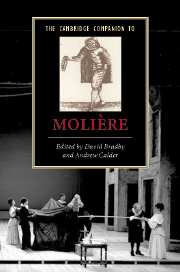Book contents
- Frontmatter
- 1 The career strategy of an actor turned playwright: 'de l’audace, encore de l’audace, toujours de l’audace’
- 2 The material conditions of Molière’s stage
- 3 The master and the mirror: Scaramouche and Molière
- 4 Molière as satirist
- 5 How (and why) not to take Molière too seriously
- 6 L’Avare or Harpagon’s masterclass in comedy
- 7 Laughter and irony in Le Misanthrope
- 8 Comédies-ballets
- 9 Le Bourgeois gentilhomme: Molière and music
- 10 Medicine and entertainment in Le Malade imaginaire
- 11 Molière and the teaching of Frenchness: Les Femmes savantes as a case study
- 12 L'École des femmes: matrimony and the laws of chance
- 13 Molière nationalised: Tartuffe on the British stage from the Restoration to the present day
- 14 Landmark twentieth-century productions of Molière: a transatlantic perspective on Molière: mise en scène and its historiography
- 15 Dom Juan the Directors’ Play
- 16 ‘Reculer pour mieux sauter’: modern experimental theatre’s debt to Molière
- Select bibliography
- Index
- Series List
3 - The master and the mirror: Scaramouche and Molière
Published online by Cambridge University Press: 28 March 2007
- Frontmatter
- 1 The career strategy of an actor turned playwright: 'de l’audace, encore de l’audace, toujours de l’audace’
- 2 The material conditions of Molière’s stage
- 3 The master and the mirror: Scaramouche and Molière
- 4 Molière as satirist
- 5 How (and why) not to take Molière too seriously
- 6 L’Avare or Harpagon’s masterclass in comedy
- 7 Laughter and irony in Le Misanthrope
- 8 Comédies-ballets
- 9 Le Bourgeois gentilhomme: Molière and music
- 10 Medicine and entertainment in Le Malade imaginaire
- 11 Molière and the teaching of Frenchness: Les Femmes savantes as a case study
- 12 L'École des femmes: matrimony and the laws of chance
- 13 Molière nationalised: Tartuffe on the British stage from the Restoration to the present day
- 14 Landmark twentieth-century productions of Molière: a transatlantic perspective on Molière: mise en scène and its historiography
- 15 Dom Juan the Directors’ Play
- 16 ‘Reculer pour mieux sauter’: modern experimental theatre’s debt to Molière
- Select bibliography
- Index
- Series List
Summary
Qualis erit? tanto docente magistro. What will he be like with such a great master? With hindsight it is difficult to know how seriously to take the question accompanying the frontispiece illustration to Le Boulanger de Chalussay's attack on Molière (fig. 7). Though Weyen's print has been described by the Italian theatre scholar Ferdinando Taviani as perhaps the only image we have of a seventeenth-century actor transmitting his knowledge to another, the same scholar reminds us that, whereas a similar image would not be out of place in an eastern context, or if it had depicted western clowns, acrobats or dancers, this one in particular is a satirical depiction of two actors, and therefore its overriding intention is the denigration of its target, Molière.
If this is so, then presumably the satire is intended to function by the association of the French actor/author with the great Neapolitan actor/clown Tiberio Fiorilli, studying his comic grimaces with the aid of a mirror and under the threat of an eel-skin whip. This chapter will examine the extent to which we can trace this relationship and the effect it has had upon both Molière's own acting and the acting of Molière in France and Italy at the close of the twentieth century. Starting with seventeenth-century eyewitness accounts, I will concentrate particularly upon the implications of Molière's relationship with Scaramouche for his jeu or style of playing. Developing positions put forward by H. Gaston Hall, I will consider the interplay between the French farce tradition, the Italian comic actors' reliance on physicality and the relationship of mask to seventeenth-century theories of physiognomy.
- Type
- Chapter
- Information
- The Cambridge Companion to Moliere , pp. 37 - 56Publisher: Cambridge University PressPrint publication year: 2006



